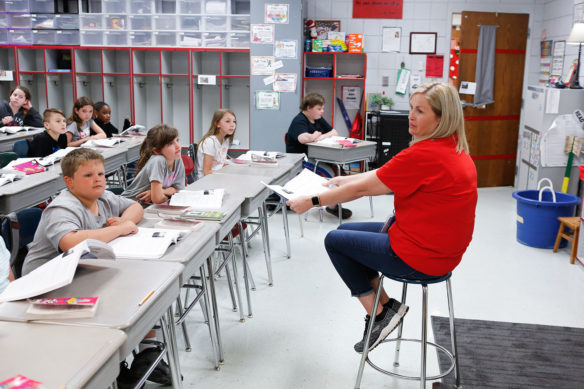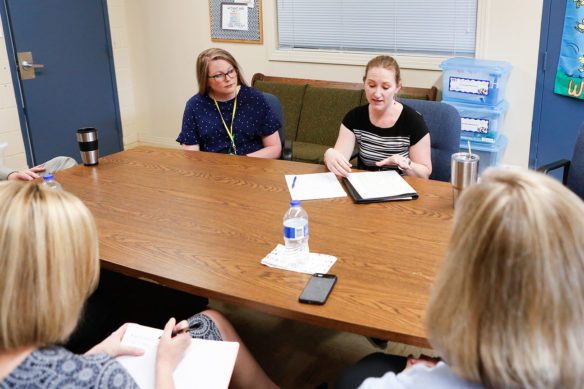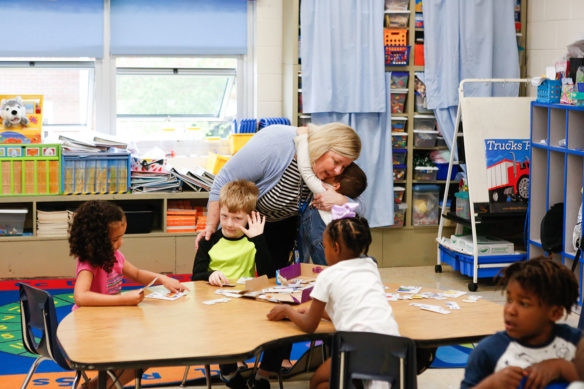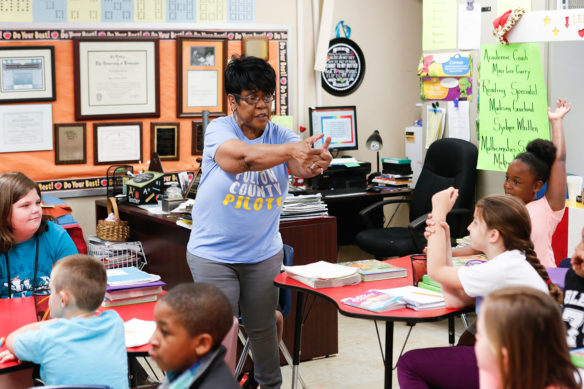
Trina Fuller shows a book to her 4th-grade students at Hickman County Elementary School during a reading lesson. The school is one of three west Kentucky schools that took part in a research reading intervention project during the 2018-2019 school year that was supported by the Four Rivers Foundation.
Photo by Mike Marsee, April 23, 2019
- Flexibility has been a hallmark of the project funded by the Four Rivers Foundation.
- The project began during the past school year in Fulton and Hickman counties and a Fulton Independent school, and the foundation hopes to expand it to Ballard and Carlisle counties in the coming school year.
By Mike Marsee
mike.marsee@education.ky.gov
There’s more than one way to build better readers.
Flexibility is the focus of a research reading intervention project that is yielding fruit at three elementary schools in west Kentucky. The project is designed as a Response to Intervention (RtI) to increase student proficiency in reading for students in the 3rd and 4th grades by focusing on what they need within each school and within small groups of students.
The Four Rivers Foundation, which works to create opportunities for success for students in a service area that includes the five school districts in Kentucky’s four westernmost counties, has spearheaded the project in partnership with professors Christina Grant of Murray State University and Ruth Jefferson of Ball State University.
The work began in August with 3rd- and 4th-grade students in Fulton County Elementary School and Carr Elementary School (Fulton Independent), and Hickman County Elementary School was added to the project in January. Dianne Owen, director of the Four Rivers Foundation and a former superintendent of Fulton Independent schools, said the foundation hopes to add elementary schools in Ballard and Carlisle counties in the coming school year.
Amanda Ellis, chief academic officer at the Kentucky Department of Education and a former elementary school principal, said that level of focus makes this program stand out.
“Reading instruction has not changed that much at all, but what’s happened is we don’t focus on the details of it any more,” Ellis said.
The project uses McGraw Hill’s SRA Corrective Reading and SRA Reading Laboratory programs, as well as other resources, including the Heggerty Phonemic Awareness curriculum, Peer-Assisted Learning Strategies (PALS) and the Aimsweb progress monitoring and RtI system.

Christina Grant, an assistant professor at Murray State University, discusses the results of a research reading intervention project as Ashton Giles, a 4th-grade teacher at Fulton County Elementary School, looks on. Grant said the project is based on research-based strategies for literacy and includes structure and organization for teachers.
Photo by Mike Marsee, April 23, 2019
Grant said the work – which is based on an idea that she said has worked at schools in Indiana – began in August at Fulton County Elementary School, where some of those materials were already on hand.
“We started off with a broad idea: good, research-based strategies for literacy across the board, but with more of a schedule and a regimen that creates structure and organization for teachers who felt like they needed that,” Grant said.
That schedule emphasized small groups and differentiation, with teachers meeting regularly with students who were grouped according to their needs, such as fluency or comprehension.
“We made sure that there were smaller groups in the areas that needed it,” Grant said.
Students in each of three groups worked with teachers twice a week during part of their class time in what became known as WIN (What I Need) time. The schedule focused on tasks the students were to complete each day, such as silent reading, expressive reading with voice and/or hand gestures, choral reading, teacher reading, drawing and describing a visualization and writing down questions, text connections or a brief summary.
“This is time for me to get what I need, the skills I need to be successful,” Principal Sondra Gibbs said.
Gibbs, who also is the program director, took over as principal at Fulton County Elementary in July and was charged with implementing the program for the start of the school year. She said the buy-in from teachers wasn’t total at first, but it did come.
“If you get a group of teachers together and there’s a passion for something, they’re going to come up with a plan for what’s best for children,” she said.

Sondra Gibbs, the principal at Fulton County Elementary School, gets a hug from a student. Gibbs, who serves as program director for the research reading intervention project, said changes at her school that have resulted from the project have affected both students and teachers.
Photo by Mike Marsee, April 23, 2019
Students were assessed in November by a team put together by Grant – she hopes to eventually train the teachers to do that themselves – and changes were made based on those results. For example, teachers began to use less choral reading and more expressive reading.
“We noticed that they really enjoyed the expressive reading,” Grant said. “The kids get to decide – with teacher input – what is going to help them remember that sequence of events.”
“It truly helps with vocabulary also,” said Ashton Giles, a 4th-grade reading teacher at the school. “That’s something we struggle with in a high-poverty area, and that helps the comprehension. When they have a small vocabulary, even just those movements help them remember what the words mean.”
Giles said repetitive reading also has been a valuable tool.
“We had one story with a baseball player, and we read that story for eight weeks,” she said. “We got the parents involved, too. I sent home a passage each week so they could also practice with their parents at home and said, ‘Go home and expressive read to your parents.’ We got some questions at first: ‘Why does my child have to read this every night?’”
Grant said she made sure teachers were ready with the answer to such questions.
“We really want to emphasize that it’s really making them a better reader or that they’re growing in their reading ability, not because of a test they have to take. It is helping them to be that great citizen we want them to be,” she said.
Grant said data is still being aggregated, but she said her team saw these things in the assessments:
- An increase in vocabulary;
- A significant increase in SRA levels;
- A slight increase in retelling or summarizing the story;
- A sharp increase in the overall mean on the Star reading assessment, which she said is a good measure of choral reading fluency and individual reading level; and
- A sharp decrease in reading miscues.

Beverly Claybrooks makes a point to students in her 2nd-grade classroom at Fulton County Elementary School. The school is one of three west Kentucky schools that took part in a research reading intervention project during the 2018-2019 school year that was supported by the Four Rivers Foundation.
Photo by Mike Marsee, April 23, 2019
Owen said Grant also assisted with work at Fulton County High School as educators there worked to help students try to catch up.
“We knew we had missed some students, and we got some SRA kits and put them in,” Owen said. “We finally did RtI in the way you’re supposed to.”
Gibbs said the changes at her school that have resulted from the project haven’t stopped with the students.
“It’s just been wonderful to see the implementation of the program, to have resources for our children and to see the growth throughout the building, not just with the kids but with us as a faculty,” she said. “The conversations have changed from the beginning of the year until now, how we talk about strategies and the technical piece of reading. I think it’s important to see some of this generalized into science and social studies and into the core as well.
“It’s also showed us areas where we can even do more. We’re looking at how to incorporate this on a smaller scale into the 1st and 2nd grade.”
The project looks decidedly different at Hickman County Elementary, which Owen said needed fewer materials but a sharper focus on interventions.
That intervention came from Grant and Holly Bloodworth, the 2014 Kentucky Teacher of the Year and a professional learning coach with the West Kentucky Educational Cooperative focusing on literacy.
“It was perfect timing,” Principal Richard Todd said. “We had improved, and then we plateaued a little bit the last couple of years. This has reinforced some things we’re doing right, but it also has reminded us of some things we need to get back to. The biggest help has been in giving us better direction on interventions.”
Grant said much of their work at Hickman County Elementary centered around professional development, including paying for a group of teachers to attend the Kentucky Reading Association’s annual conference with project funds.
“Maybe Holly and I planted some seeds and they said, ‘Let’s really look a little more at differentiation for the ones that need it,’” Grant said. “‘We’re showing great growth, but there’s a small select few that are not showing the growth that they need. What can we do to figure that out?’”
Hickman County Elementary is working with students in the 5th and 6th grades as well as grades 3 and 4.
One thing that Todd said the school will do in the coming school year is place students in specific homerooms based on data so they’ll have easy access to the groups in which they spend a total of 45 minutes at four reading stations.
“We want to be able to get them all the help that we can,” he said.
MORE INFO …
Dianne Owen dianne.owen@fulton.kyschools.us
Ashton Giles ashton.giles@fulton.kyschools.us
Sondra Gibbs sondra.gibbs@fulton.kyschools.us
Christina Grant cgrant4@murraystate.edu
Richard Todd Richard.todd@hickman.kyschools.us




Leave A Comment